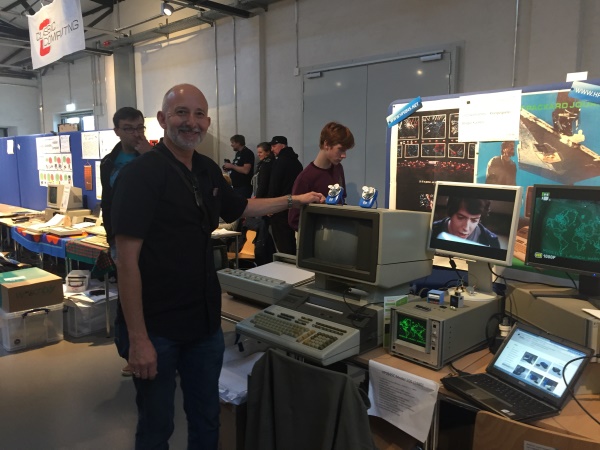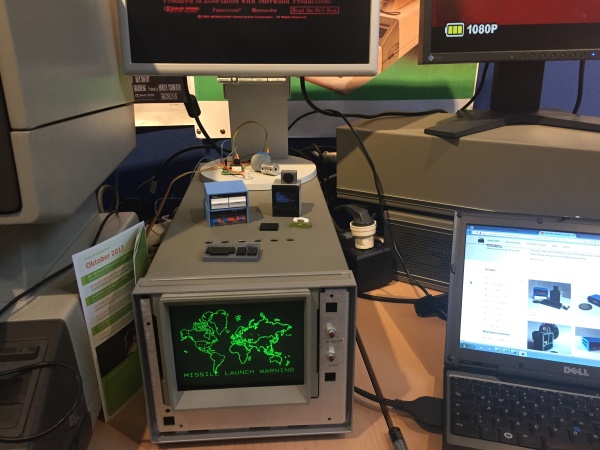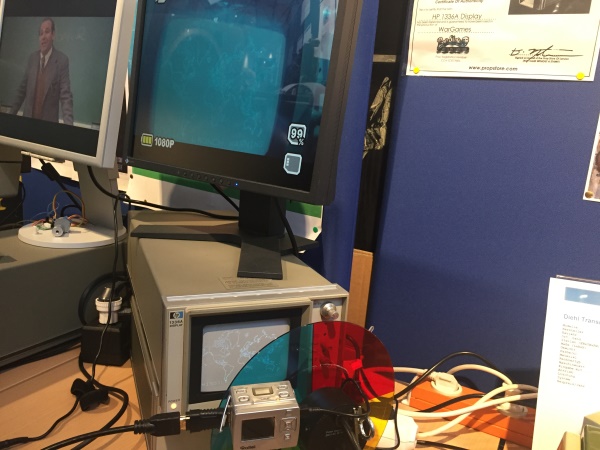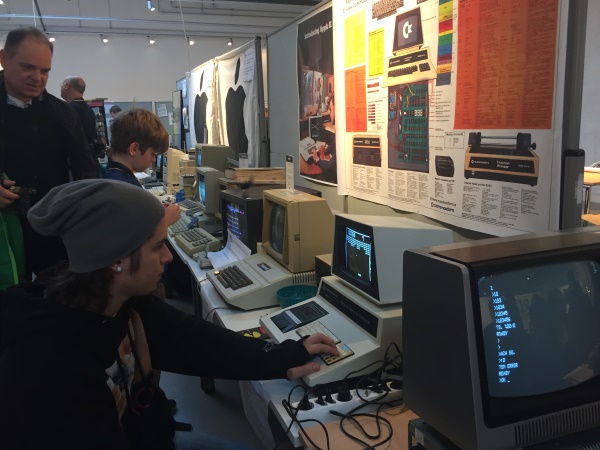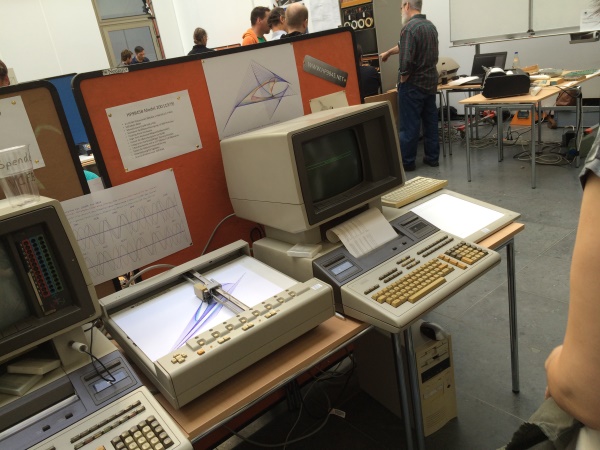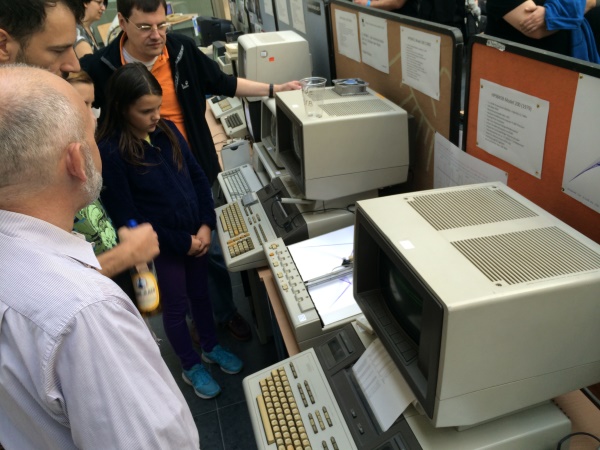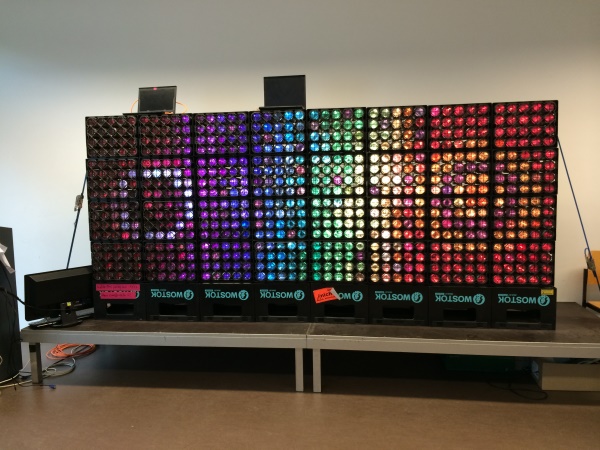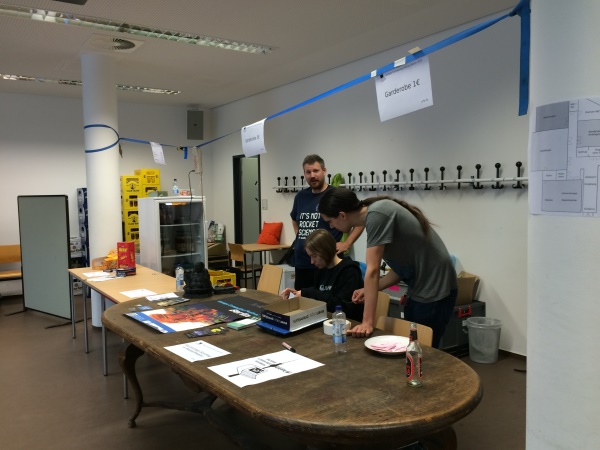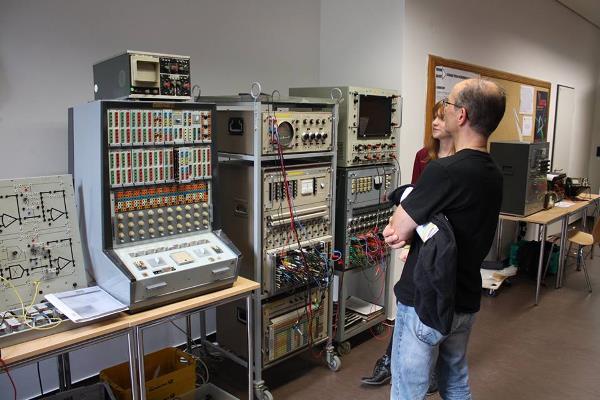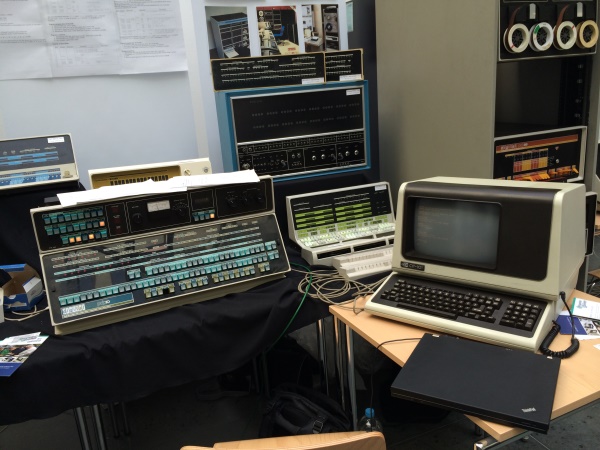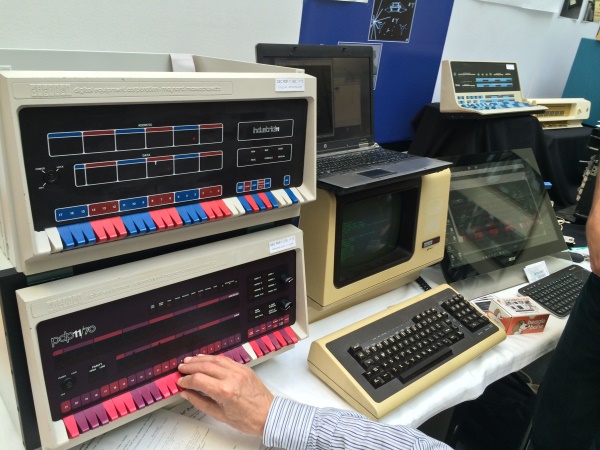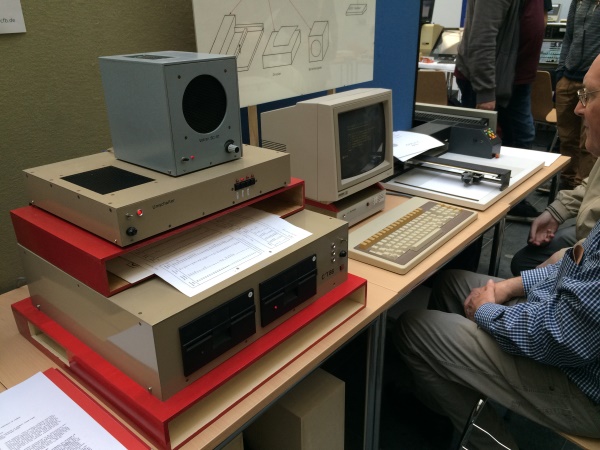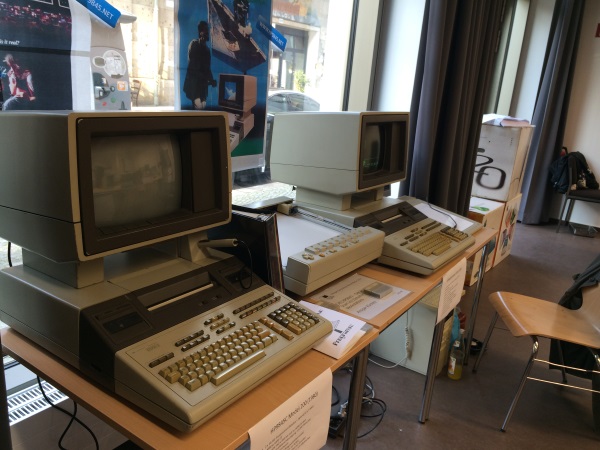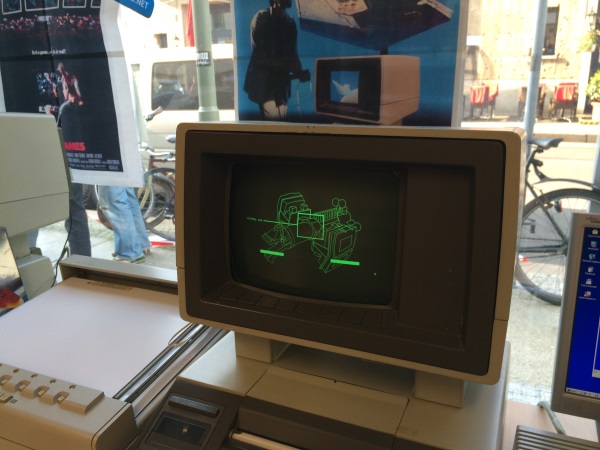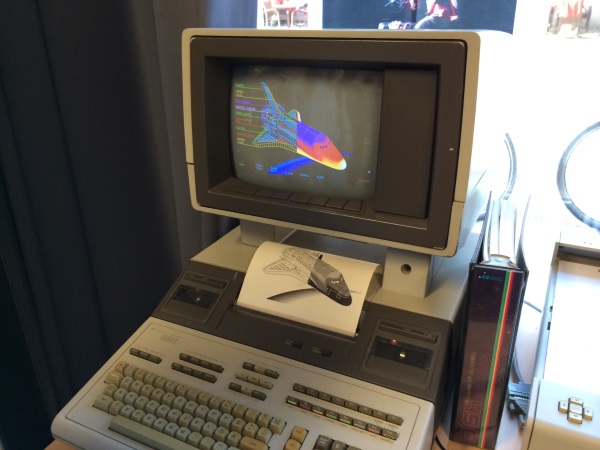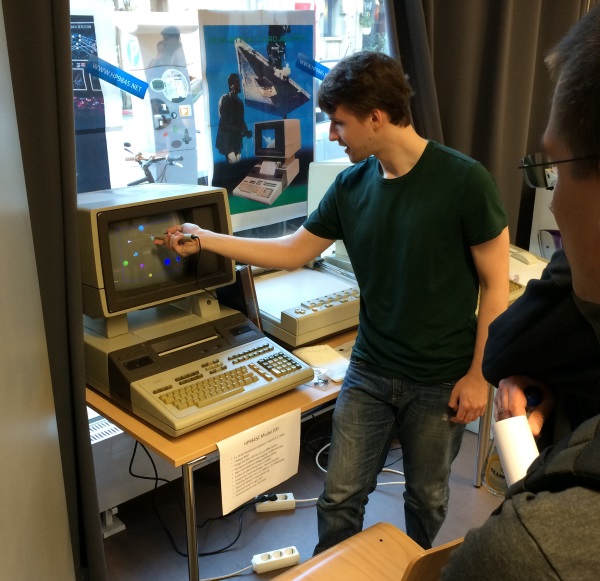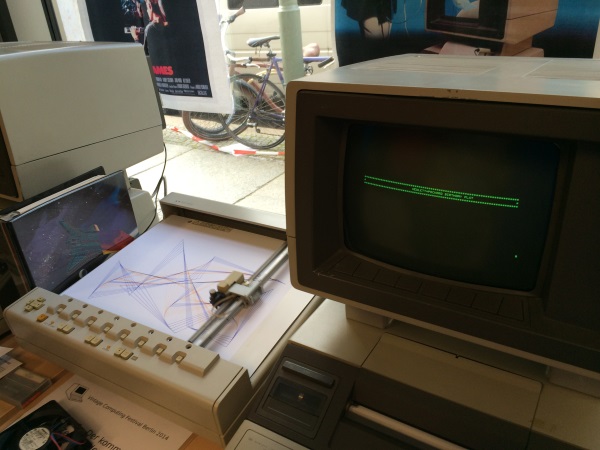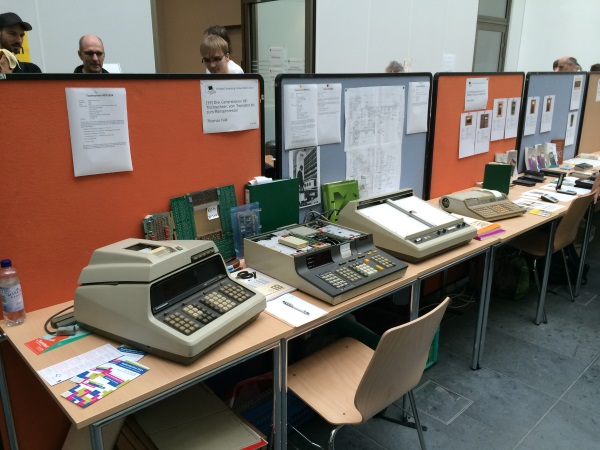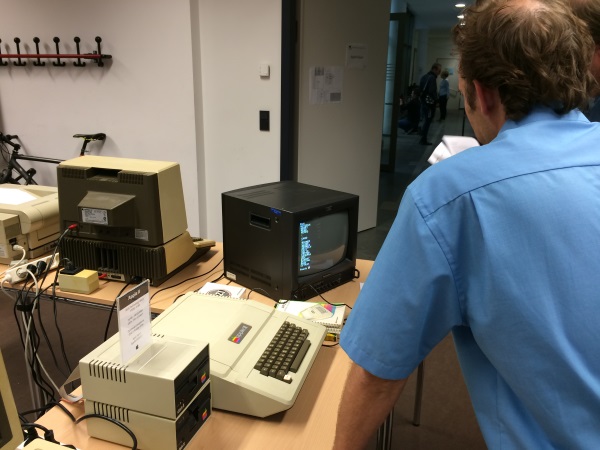The Vintage Computing Festival Berlin 2019
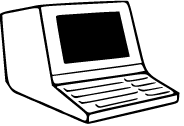
Again being guest in the Technical Museum of Berlin, we could attract 2,500 visitors to the festival, and more an more kids (see the pictures). This time we had a focus in computers from Germany (yes, really, Germany once had been some kind of ahead of the development with Konrad Zuse :-) but also later on there had been special production lines, Like HP creating workstations in Böblingen, Star Office programming the base for current OpenOffice/LibreOffice or Robotron in the former German Democratic Republic).
I did not have enough time to do another project in 2019, so I decided to re-show my War Games setup from 2017. With some more backgrounds.
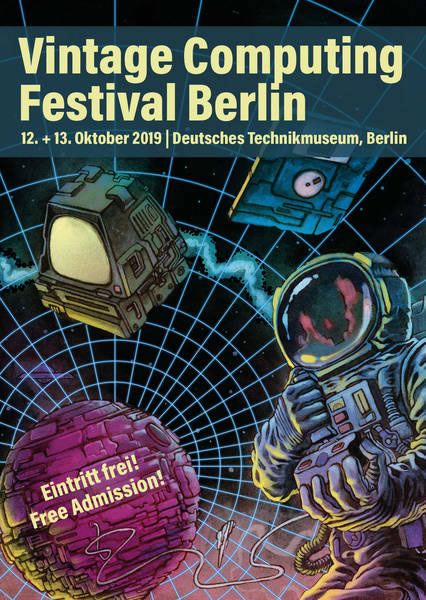
The Vintage Computing Festival Berlin 2018

Main topic this year has been "Graphical User Interfaces", starting with early developments around the Xerox Alto and many other exhibitions including Macs and computers running GEM. I again showed two exhibitions: one exhibition with e re-build of the famous Apple-1, and another (again together with Klaus) showing the TEMPEST Edition of the HP 9845B. Both exhibitions were accompanied by sessions on the same topics. The first session was about the early Apple years, the Apple-1 itself, and about the process of re-building an Apple-1 as close to the original as possible. The other sessions was about vulnerabilities caused by eminations, and countermeasures in the early times of computing.
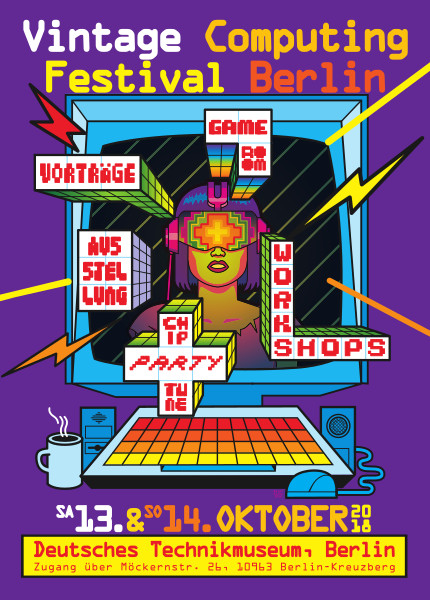
This year transport in total had been much easier because less equipment had to be moved (an Apple-1 in fact works out to be quite handy). But the TEMPEST Edition of the HP 9845 with its massive shielding in fact has been the heaviest system I ever moved.
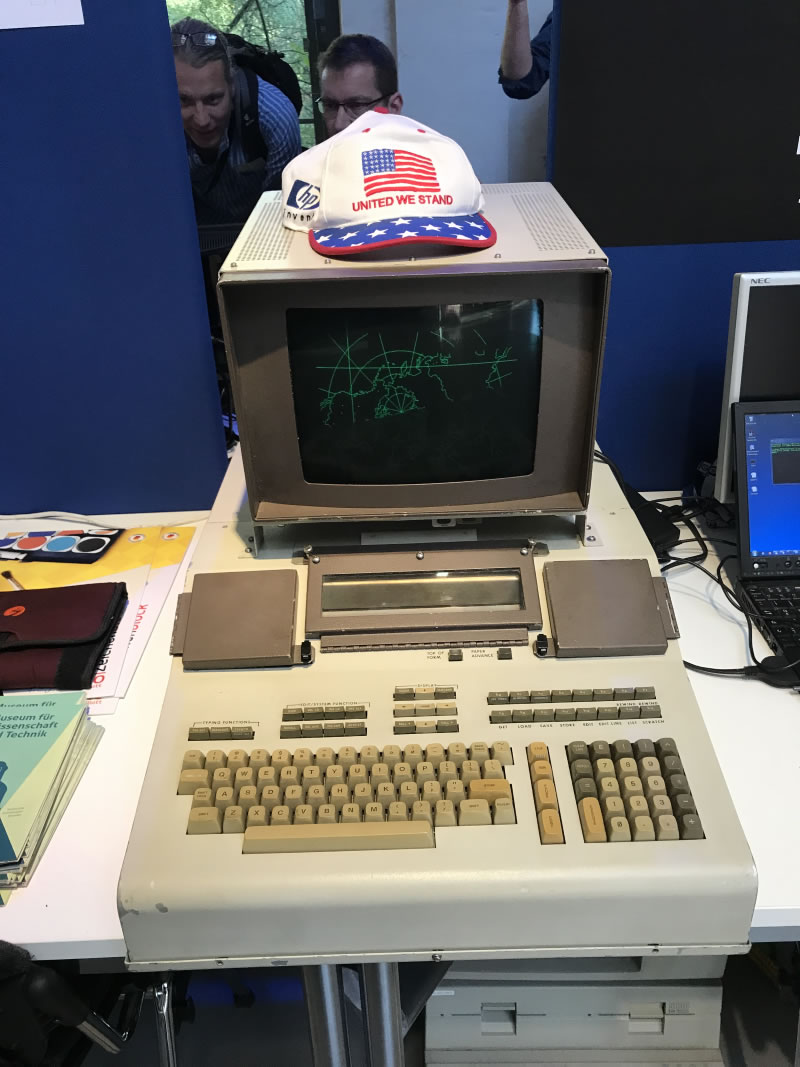
HP9845 TEMPEST Edition
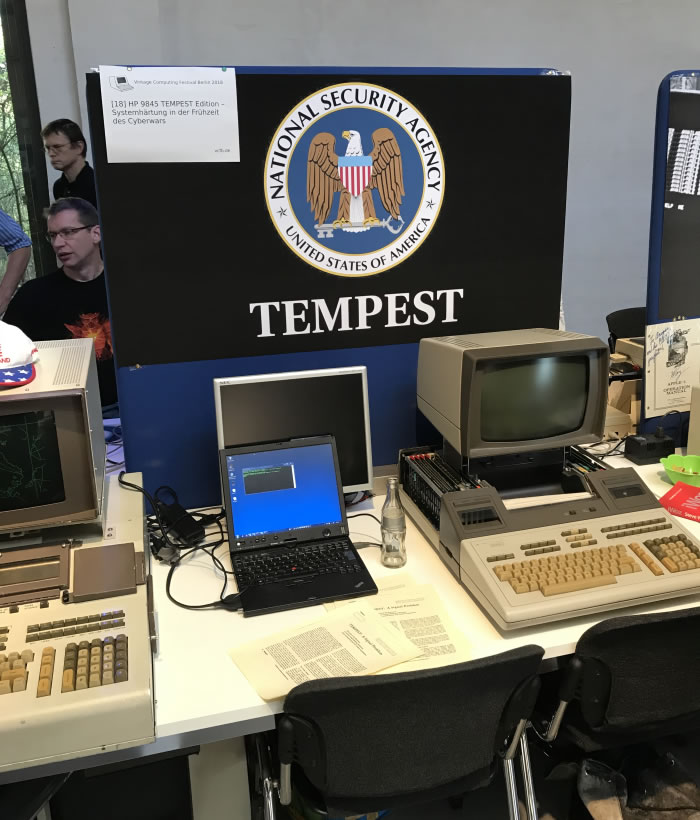
Full Setup with TEMPEST Edition on the Left, and Normal Edition on the Right

Complete Apple-1 Setup with Sanyo 4209 Monitor, Apple-1 Board, Apple II Keyboard, Self-Built PSU and
Panasonic Tape Recorder, All Built-Up With Original Components
The Vintage Computing Festival Berlin 2017

The special exhibition area this year was organized under the theme "Computer Clubs". I actually showed two exhibitions: one on the "1977 Trinity", with contribution to the famous three computers launched in 1977, the Apple II, the TRS-80 and the Commodore PET, and another exhibition on the making of the cult movie WARGAMES from the year 1983.
The 1977 Trinity exhibition had been longly planned, since we celebrate the 40th anniversary this year. The exhibition on WARGAMES, however, was only possible because of the lucky instance that Colin Cantwell, the creator of the amazing computer graphics which had been projected on the giant screens on the NORAD set, recently sold the original production equipment via an auction. I got it from a prop store in Los Angeles (who bought them in the auction), and managed to reconstruct the original production setup with the original equipment.

Altogether it again had been an exciting experience, with an amazing number of cool exhibitions, lots of passionate vintage nerds, and everything hands-on to touch & try, nothing behind walls of glass. I cannot show all the great exhibitions here because I did not take so many pictures, they are were phantastic, but as always, if you have your own exhibitions there is not enough time to check all the others.
You can find a great collection of pictures here (thanks to René Meyer): http://www.schreibfabrik.de/img/vcfb2017/
And the CCC recordings here: https://media.ccc.de/c/vcfb2017.
Also have a look on the backgrounds of the use of HP equipment in the WARGAMES section.
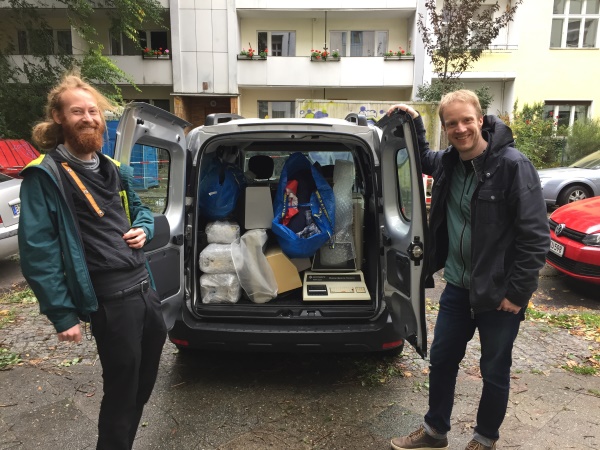
Ingo and Matthias Preparing for the Transport to the Technical Museum
The exhibitions would not have been possible without the help of Ingo and Matthias. Thanks for getting that fragile stuff securely to the convention location!
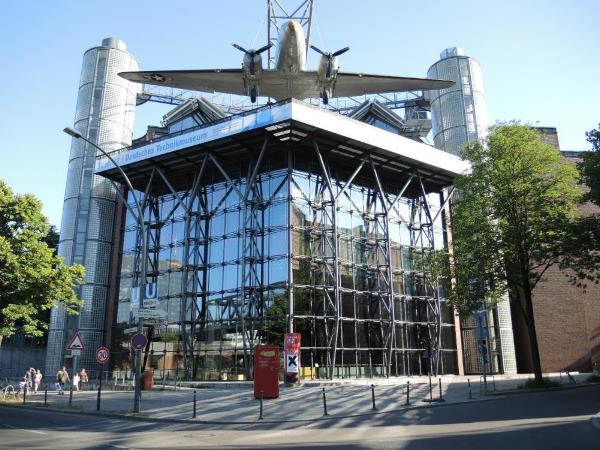
Technical Museum of Berlin
Perfect location for providing the right environment for vintage high-tech!

Floor Plan
We had lots of space, and roundabout 2,500 visitors during two days. Of cause again including the room for the lectures, the Fix-it Area, and the Game Room, but also with a nice cafeteria.
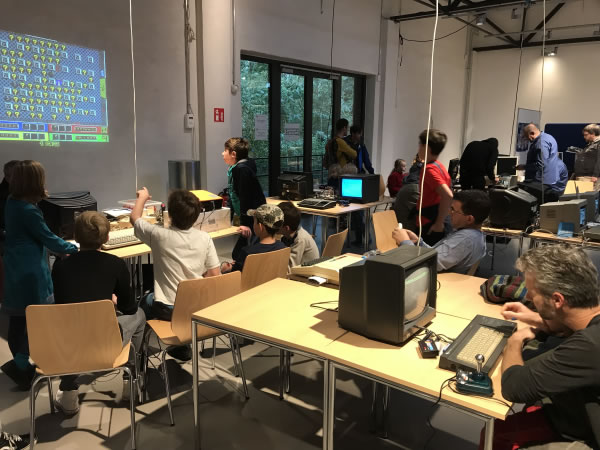
Game Room

Fix-it Area (Photograph René Meyer)
One of the exhibitions I personally liked most again was that of Oscar and Jack with the replicas of famous minicomputer systems:
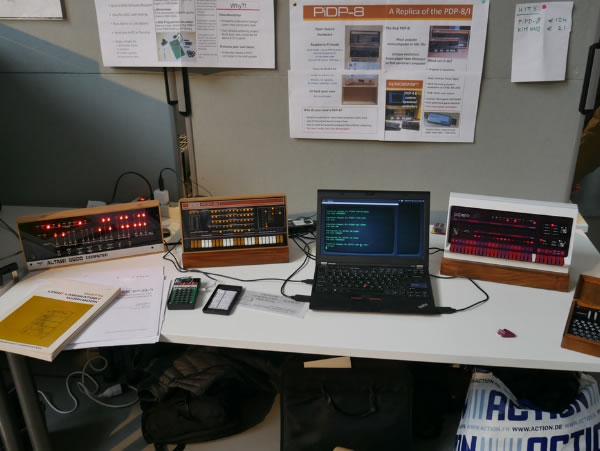
Open Source Replicas of Historical Computers (Photograph Heise)
And here is an impression of our neighbour exhibition from the Museum of Historical Office Technology Naunhof (they made the second place in the visitor's award by the way, watch that Drum Storage!!):
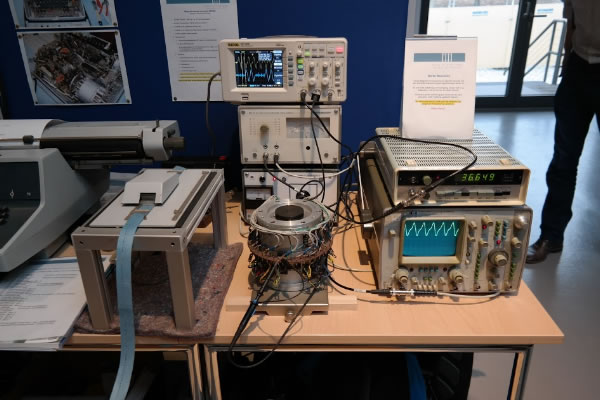
Exhibition from the Museum of Office Technology Naunhof (Photograph Marc Harnisch)
Now here is the setup, as we showed it in our WARGAMES exhibition:

WARGAMES Exhibition
I tried to reconstruct as much as possible of the original WARGAMES production setup. The plotter in fact was added just for having a more tangible output of the NORAD graphics, and also for producing giveaways for the visitors. All components are interconnected via the HP-IB instrument bus. The whole setup could be controlled by the HP 9845C workstation. Plotter and vector generator were connected via 98034 HP-IB interface, the stepper motor of the color filter wheel via 98032 GPIB interface and a stepper motor driver circuit. Not visible is the 9895A 8" floppy disk drive below the desk, also connected via HP-IB.
The laptop served as source for the WARGAMES trailer and could be used as backup controller for the HP-IB bus.
Klaus as a Presenter
Klaus arrived from San Diego, CA, mainly for supporting me with the presentations. He contributed the IMSAI miniatures and great giveaways (vintage HP mini-fans), and is the real reason why we won the visitor's award. Chapeau, Klaus!

And That's Me :-) ..
We had so many visitors, that we had no breaks in between. The only drawback is that we had not much time to check the other outstanding exhibitions as much as we would like to do :-(
1347A Vector Generator (Prototype) with IMSAI Miniatures
The 1347A vector generator actually had been the heart of the original setup. HP once donated them as a prototype (the 1347A first appeared in the 1984 catalog). This is also the reason why the front bezel is missing. The 1347A vector generator was capable to address 2048 by 1513 points. Fortunately, Colin Cantwell preserved them in his private collection and offered them last year in an auction where he also gave away his props from the Star Wars movie, so we can show them today. The green vector display actually is for preview purposes only. The actual output is done via analog XY signals via BNC connectors in the back of the device by a 1336A high resolution XY display.
The prototype has a different firmware inside than the final versions. However, the programming manual for the 1347A could be applied in most cases, so it was possible to control the vector generator via HP-IB. The 1347A vector generator also offers a second HP-IB connector to directly connect to a 9872 plotter for hardcopies.
Recording Setup with Monitor
In the original setup, a Mitchell Camera Corp Model NC 35mm was used for taking the graphics on 35mm film. In our setup, we simulate this with a GoPro Cam. The output is showed on the monitor above. Is there anyone out there who likes to donate a Mitchell Camera?
1336A High Resolution XY-Display, Color Filter Wheel and Camera
The display of the 1347A vector generator was not suitable for taking the graphics. One reason was that the resolution wasn't high enough, another that it produced green images only. The 1336A XY-Display was one of the highest resolution vector displays on the market with 360 lines per inch (mostly used in medical applications), which is what Apple today calls "Retina Display". This resolution was perfect even for the giant NORAD projections.
Also, the 1336A display used a white phosphor. So with a color filter wheel driven by a stepper motor, the graphics animations could be created frame by frame with three exposures per frame (one for red, green, and blue separation). Originally it took about one minute per frame, 24h a day, over a period of several months. This was only possible because the vector generator, the color filter wheel and the Mitchell camera all had been remotely controlled in a batch run by the HP 9845C workstation.
But here also some impressions from my other exhibition:
The 1977 Trinity Exhibition with Apple II, Commodore PET and TRS-80
1977 was a remarkable year for the evolution of the personal computer. Three companies, Apple, Commodore and Tandy introduced ready-to-use computers for the masses, where the market had been dominated up to then by either professional IT (represented primarily by mainframes and minicomputers) or hobbyists assembling their small systems from kits (like the Altair or the KIM-1). The outcome before had been uncertain, but the success was overwhelming. So 1977 can be considered as the start of the personal computer business.
Apple II and PET In Action
See here an original Apple II with Woz' Integer BASIC (not Plus or Europlus). The green monitor is connected to a 80 character board, the standard output goes to the NTSC monitor to the left (currently in use for Galaxian). The PET looks more like 2001 Space Odyssey..
TRS-80 Model I
Here you see two versions of the TRS-80 Model I, the earlier with black and white RCA monitor, original expansion interface (note the ribbon cable with active driver box), cassette drive and less keypad (originally shipped with Level I BASIC). The later version on the right with more decent green Sanyo monitor, two floppy discs, revised expansion interface and with separate keypad. Some covers on the expansion interfaces are missing (as with most TRS-80 today).
In the 70s, the design was really cool and spacy (not as fancy as the Apple II, though).
The Vintage Computing Festival Berlin 2015

The special exhibition this year was organized under the theme "Analog Computers", which indeed played a very special role over a long period, however memory is slowly fading away in our strictly digital world today.
Of course also the 9845 setup again had been part of the exhibition. In contrast the the Vintage Computer Festivals (VCF) in the U.S. the VCFB has its focus on "computing" rather than "computers", comprising operating systems, software, programming languages, network technology and computing concepts in general. Which is the perfect stage for the 9845, which really had been a conceptual wonderpiece. Not as groundbreaking as the Alto in 1973, certainly, but from an engineering point of view exceptional with its integrated and unified approach, its user interface technologies and of course its graphics capabilities and performance.
From Right to Left: HP 9114 Digitizer Tablet, HP 9845 Model 200,
HP 9872C Plotter, HP 9845C, HP 9895A Dual Disc Drive
The setup in general had been the same as last year, and I could happily again demonstrate a 9845C in action. New was that I could equip the 9872C with eight different colour pens, so that the famous "Birthday Plot" shined in rainbow colors. Again every visitor could take his or her own plot as souvenir. Also I used a real 9895A 8" dual disk drive in addition to a HPDrive station. Thanks to a separate power line circuit, we this time could successfully avoid breaking down the power for the whole exhibition as we exercised last year :-).
We could welcome many friends of old HP equipment, and special thanks go to Klaus Kaiser, who supported me through the whole exhibition from the buildup until the transport back to my home, and again my son who exhaustively helped me moving those heavy beasts. Again it had been lots of fun, and we finally even had been successful with reviving the 9845B Model 200, which obviously disliked the transport to the exhibition court which it honoured by simply not starting up any more. However, in the end, it had been much fun and we had great talks.
The 9845 setup had been supplemented by a collection of milestones of the personal computers. This included a Commodore PET 2001 with floppy disk and tractor printer, an Apple II from 1977 (same year the first 9845 was introduced) with two Apple Disk II, and for comparison an original IBM PC Model 5150 with triple-head display (Hercules, CGA and NTSC video monitor), showing the brand new mindbreaking (and emulator-breaking) 8088MPH demo in addition to MS Windows 1.01 and many well-known standard applications. As a special I could demonstrate Space Invaders on all platforms in parallel.
From Left to Right: CBM 3040 Dual Floppy Drive, Commodore PET 2001, Apple II with Apple Disk II and Apple Monitor,
IBM 5153 Color Monitor, Video Monitor, IBM 5150 with IBM 5151 Monochrome Monitor
I also had the opportunity to present a wrap-up of workstation history from the very beginning over the Alto up to the last examples today within a one-and-a-half hour lecture in German (see https://media.ccc.de/c/vcfb15 for a collection of live stream recordings).
Of course Colin Cantwell's famous 9845C demo also was part of the show:
9845C Shuttle Demo
Gravity Game
Some more impressions:
9872C Plotter in Action
Who Wants His/Her Personal Plot :-) ?
Running the 8088mph Demo
Wall of Fame
Mate Lights
Organization Crew
Analog Computers Special Exhibition (Source: Computerarchäologie)
PDP Front Panels (Visitors Award #1)
More PDP Front Panels
ct' 86 Computer (Visitors Award #2)
Game Room
The Vintage Computing Festival Berlin 2014

A special sub-exhibition was dedicated to the Apple story, starting with the Apple II up to the latest models, all ordered in a continuous time line. The exhibition was accompanied by a congress track with lectures and presentations on several computing topics. A soldering laboratory offered especially for young visitors an introduction into the assemby of autonomous robots, the Pentabugs. A special games room offered hands-on experience on a large number of home computers and game consoles from the late 70s up to the late 80s. A late night party event utilized 8-bit computers for creating music for the dance floor. Each day more than 800 visitors came to the VCFB. Altogether it was lots of fun...
Actually I got notice of the event quite late, however I immediately decided to bring at least a basic collection of HP 9845 to the show (in addition to the contribution of my Apple II). The setup included a 9111A digitizer tablet, a 9872C eight-color plotter, an HP 9845B model 200, and - as a highlight - a working HP 9845C model 200. But - believe me - since the preparation time was short, it was quite a challenge to get the 9845C into a working condition in time (whoever owns such a beast knows what I am talking about).
But at Friday everything was ready for transport to the exhibition. Fortunately the VCFB organized the transfer, so I could use the afternoon for installation and preperations. See the following photograph for the resulting setup.
HP 9845 Demo Setup on the Vintage Computing Festival in Berlin
Instead a floppy or hard disk drive I decided to use a PC basd solution with HPDrive. Not as authentic as the real hardware, but much more flexible. The show included François Lanciault's self-programmed 98780A demo, several digitizer & plotter demos, and - of course - HP's own great HP 9845C demo. The facilities were not really prepared for so much power consumption, and we had several power-fails during the exhibition. Which fortunately always could be quickly recovered. Because of power requirements, just one of the two HP systems could be run at the same time, so I had to switch between both. See the power-meter on the floor for checks on the power consumption of the setup.
Workstation Power
For the 9845C the forced breaks finally showed to be a good thing for cooling down the system from time to time, especially the 9770A power supply transistors are running extremely hot during continuous operation (probably due to some current leakage), so it was much better for the system to recover eventually. Both HP 9845 systems are equipped with two cartridge tape drives each plus internal printer. The HP 9845B is a model 200 with bit slice processor and 512 kByte RAM, the 9845C also is a model 200 with bit slice processor but full 1.5 MByte RAM, the maximum configuration (!).
François Lanciault's Self-Programmed Demo
François Lanciault from Canada created a mind-blowing space ship demo which takes advantage of any of the features of the 98780A accelerated graphics monitor. It runs as a continuous display as it might be installed within a space ship, monitoring navigation and ship status. The role of the HP9845 as a movie star was demonstrated with reference to the Star Wars and the War Games movies.
HP 9845C Space Shuttle Demo - The Original
Of course the space shuttle demo was a must. It impressively demonstrates the line generation and dithering speed of the 98770A graphcs system in first drawing the shuttle slowly and then at full speed. With a single press on one of the monitor's softkeys (at the bottom of the screen) the integrated printer produced a hardcopy on thermal paper for any visitor as takeaway. In direct comparison to all the other systems on the exhibition, the high quality and precise color graphics still outperform anything else from that time.
The 9845C Light Pen in Action
One of the most interesting learnings for the visitors was how at the time different concepts for human interfacing were implemented. It was not yet clear at the time, which type of human interface is best suited for computer interaction. Of course the digitizer tablet was used for the digitizing as well as for cursor movement. And for certain applications, it still has advantages over the computer mouse, since it is more precise and not affected by different angles when holding a mouse. A more intuitive way was to combine menue labels on the screen with softkeys installed at the bottom of the screen. But most appealing still is the precision light pen which once had been delevoped for the 9845C, here demonstrated by my son in combination with the Gravity game.
Plot Demo (Here: Birthday Plot)
This is what kids liked most: a plotter fastly drawing a personalized sketch in multiple colors. In today's computer world, nothing is moving any more than just the items on the screen. So watching a plotter in action still is something exciting. Of course the visitor could take his personal plot with him or her.
The HP9845 as a TV Star
Germany's ARD broadcasting institution sent a camera team for taking pictures for a documentation on programming which shall be broadcasted this December. Of course they could not ignore the HP 9845...
The Ancestors
The higlight however was that not just the HP9845 series was shown, but also a couple of ancestors were part of the exhibition, presented by Thomas Falk. See the fabulous 9100A calculator, a 9810A calculator and a 7210A flatbed plotter.
Forth Benchmark with My Apple II
The VCFB also initiated a benchmark competition with the Forth computing language. Here my Apple II (the original one with Woz' Integer BASIC, no Plus or Europlus) is used by one of the Forth experts (no, it's not me, just my computer :-)). And believe it or not, the Apple II won the award.
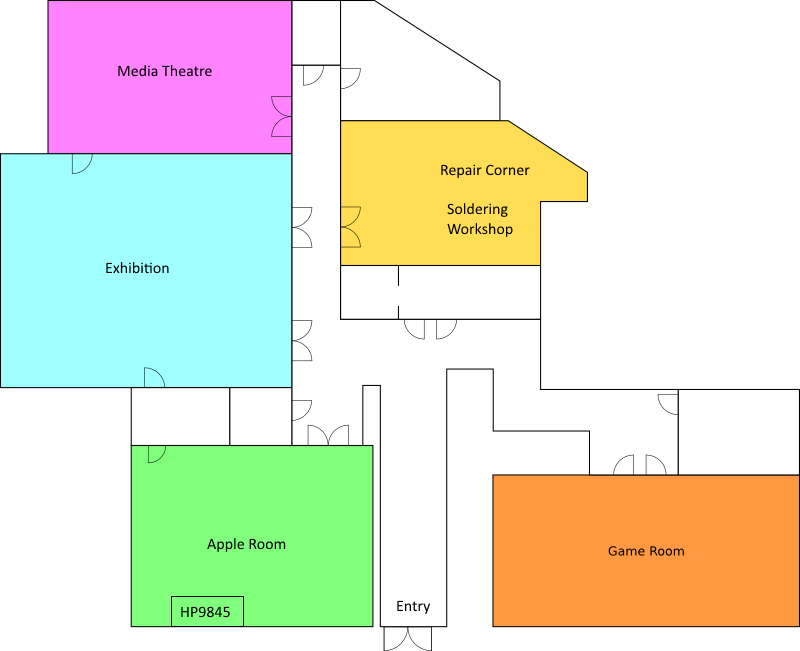
Floor Plan
I'd like to thank my son for assistance during the demos and for the transport of the heavy-weights, and also Henry for helping with the transport back from the exhibition, as well as the organising team, they all did a great job and I am looking forward to the VCFB next year, where I for sure will participate again with some of the first commercial workstations ever.
Vintage Computing Festival East 9.1 2014
Our fellow François Lanciault showed a great 9845 setup at the VCF East this year in New Jersey. Here is a photograph from the exhibition:
François Lanciault's 9845 Display at the VCF New Jersey 2014 (Courtesy of François)








